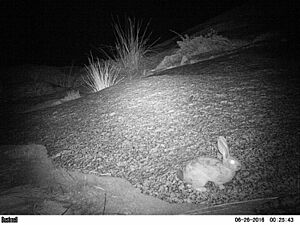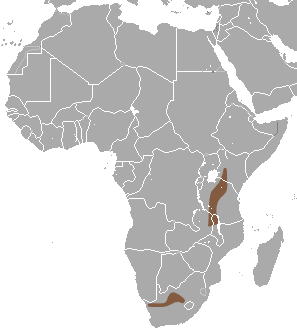Smith's red rock hare facts for kids
Quick facts for kids Smith's red rock hare |
|
|---|---|
 |
|
| Conservation status | |
| Scientific classification | |
| Genus: |
Pronolagus
|
| Species: |
rupestris
|
| Subspecies | |
|
|
 |
|
| Smith's red rock hare range | |
| Synonyms | |
|
|
The Smith's red rock hare (Pronolagus rupestris) is a type of mammal in the rabbit and hare family, called Leporidae. It is the smallest animal in its group, the Pronolagus genus.
This hare has reddish-brown fur on its back and neck. Its fur is thicker and grizzled (mixed colors) on its back, and lighter, thinner fur underneath. It lives in parts of Africa, including Kenya, Lesotho, Malawi, Namibia, South Africa, Tanzania, Zambia, and Zimbabwe.
Smith's red rock hares mostly eat plants like grasses, shrubs, and herbs. They usually have babies between September and February. A female hare typically gives birth to one or two young. Since 1996, this species has been listed as "least concern" by the IUCN Red List of Endangered Species, meaning it is not currently at high risk of disappearing.
Contents
About the Smith's Red Rock Hare
The Smith's red rock hare was first described in 1834 by a Scottish zoologist named Andrew Smith. People in Zambia often call these animals "rock rabbits." In the Swahili language, they are known as sungura mwekundu or kitengule.
Scientists have studied different types of Smith's red rock hares. Some groups of these hares are considered subspecies. This means they are slightly different types within the same species.
What Does It Look Like?
The Smith's red rock hare is the smallest of the Pronolagus hares. It measures about 43 to 65 centimeters (17 to 26 inches) long from head to tail. Its bushy tail is dark to reddish-brown with a black tip, and is about 5 to 11 cm (2 to 4 inches) long. These hares weigh between 1.3 and 2 kilograms (2.9 to 4.4 pounds).
Their fur is reddish-brown on their upper body and around their throat. Their ears are grey and measure about 6 to 10 cm (2 to 4 inches). Their hind feet are about 7.5 to 10 cm (3 to 4 inches) long. They have a brownish forehead and greyish-buff cheeks. The sides of their face are grey, and they have a reddish-brown patch on the back of their neck.
The underside of their body is pinkish-buff, with some white fur in the middle of their belly. Their back legs and rump are a bright reddish-brown. The fur on their feet is thick and greasy, helping them grip rocky surfaces. Their claws are short and wide.
This hare looks similar to the Jameson's red rock hare (P. randensis). The Jameson's hare has shorter ears and a longer tail. It also looks like Hewitt's red rock hare (P. saundersiae).
Where Do They Live?
The Smith's red rock hare lives in Africa. You can find them in parts of Kenya, Lesotho, Malawi, eastern Zimbabwe, South Africa, Tanzania, and Zambia.
They prefer to live on rocky slopes and the tops of rocky hills. They like areas where there are rocks, grass, and bushes mixed together. They often live in ravines with large rocks, on hillsides, or in rock cracks. These places offer good hiding spots from animals that might hunt them.
Behavior and Life Cycle
Smith's red rock hares are mostly active at night. However, they might come out in the early morning or late afternoon in places where they are not hunted. They are usually very alert and try to hide before anyone sees them. If chased, they can make quick, surprising moves.
These hares are known to make loud, startling screams when running away at night. This might be to scare off predators or to warn other hares of danger. Unlike most other hares, they can make shrill noises even when they are not hurt or held. Young hares make "churring" sounds if caught. Adult hares might make a "barking" sound if disturbed before sunrise.
Smith's red rock hares are herbivores, meaning they eat plants. They mostly eat grasses, shrubs, and herbs.
They breed from September to February. The female hare builds a nest using plant material and lines it with her own fur. The nest is about 15 cm (6 inches) wide, 10 cm (4 inches) long, and 4 to 8 cm (1.6 to 3.1 inches) deep. The mother is pregnant for about one month. She usually gives birth to one or two babies, each weighing about 40 to 50 grams (1.4 to 1.8 ounces). The young are born helpless and need their mother's care. They leave the nest when they are about three years old, weighing around 180 to 200 grams (6.3 to 7.1 ounces). Even though they are often seen alone, Smith's red rock hares sometimes live close to dassies, which are small, furry mammals.
Conservation Status
Since 1996, the Smith's red rock hare has been listed as a species of "least concern" on the IUCN Red List of Endangered Species. This is good news because it means they are not currently in danger of extinction. They are common in some parts of South Africa, and their habitat covers a very large area. In South Africa alone, there are more than 10,000 adult hares.
Even though we don't have exact numbers for their whole population, they are widespread and found in large numbers in places like Kuruman and Springbok. However, we don't have much information about their numbers in East Africa.
Hunting can be a threat to these hares. Also, their homes are sometimes destroyed when houses are built on rocky areas. From the 1900s to 2000, over 20% of their habitat was lost. If this continued, scientists predicted in 2004 that their population in South Africa could drop by more than 10%.
Luckily, Smith's red rock hares live in provincial parks, national parks, and wildlife refuges in South Africa. They are also protected as a game species during certain times of the year by nature conservation groups. They can be found in Lavushi Manda National Park in Zambia.


